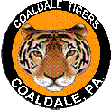Here are some excerpts:
Page 1 –LENAPE INDIANS IN COALDALE AREA-- “When the Lenape Indians scampered, in their eager chase after the deer and bear, over that part of St. Anthony’s wilderness, which is now embraced in the town of Coaldale and its confines, their lithe limbs, we fancy, could have been put to few severer tests than that of scaling the steep slopes of Locust Mountain, as we view it from the windows of St. Mary’s Rectory. What an entrancingly beautiful prospect that of the mountain and Panther Creek must have afforded before and, indeed, for many years after Philip Ginter kicked up that hard, black substance that afterward proved to be “stone coal’.”
Page 2 – FLOCKS OF WILD PIGEONS AND CHINESE PHEASANTS IN COALDALE DURING CIVIL WAR--“…a trustworthy narrator, still living, informs us that whole flocks of wild pigeons were common enough in and about early Coaldale, and he tells with much relish how, in his boyhood—the years of the Civil War—he and his companions were wont to go not far from their home near the present Water Street, look for a hole in the snowy crust, thrust in a hand, and pull forth in triumph, amid vigorous, fluttering protests, a Chinese pheasant…”
Page 4—THE EARLIEST HOUSES IN COALDALE—“The beginnings of Coaldale are dead and literally buried, for the earliest houses lie under the culm bank near the Coaldale Colliery…In 1846 six double houses were built in a row at a point just west of the old tunnel, and nearby was a mule stable with a yard. Here dwelt with their families the toilers in the early coal operations hereabout, and here were born and lived for some time few of the later estimable residents of Coaldale, among them parents or grandparents of men and women who have won an honored name among us…The houses were built of rough-boards, and it is hard to say whether they were one story or a story and a half, for the upper portion boasted no such superfluous adornment as a window…But, small though these houses were, great was the chimney, built of rough stones and taking up in its diameter a too generous share of the living space below, yet providing an immense and cheery fire-place …It is related that as the culm began to accumulate and draw near these humble cots, one of the dwellers there would stretch a plank from an embankment to the edge of the great chimney of his house, and down the chimney would crash several great chunks of virgin anthracite to the fire-place below. The name of this early exponent of efficiency and eliminater of waste motion was David Hoben, grandfather and great-grandfather of the esteemed parishioners of to-day.”
Pages 5/6— COALDALE TEACHER “SPIKER” KENNEDY, A “MAN OF BLOOD AND IRON”—“In 1848, other families came and settled in similar homes on Old Street, now First Street and on Water Street. A little later came Centreville, on the high road to Summit Hill, over which the heavy stage would pass in each direction twice a day…The children of the families of lower Coaldale received their meagre education, the best their times and circumstances could afford, in the old one-room school house, still standing on First Street, North of Phillips Street…The earliest teacher was one Cyrus Steele, of whom tradition says that he was a kindly man…But his successor, one by the name of Kennedy, and irreverently dubbed by his charges, ‘Spiker,’ was a man of blood and iron…’Spiker’ was an outspoken advocate of the Solomonesque doctrine about sparing the rod and spoiling the child. Indeed, he out-Solomoned Solomon, for his rod bore the proportions of a limb of a tree, which reposed in full view of every luckless urchin who might show signs of restiveness.”
Page 10—“OLD COALDALE” AND “NEW COALDALE”—“New Wales, or New Coaldale, came into being on what is now known as Ruddle Street, being so named as to distinguish it from ‘Old Coaldale’ on First Street and Water Street. The Ruddle Street houses were put up in 1868 and 1869. A post office came in 1871, with Charles F. Goslie as the first postmaster. Bull Run had come into being in 1864, the year of the (Civil War) battle from which it takes its name, and Gearytown two years later, taking its name from the governor of the state, John W. Geary.”
Page 17—"FOUNDING OF COALDALE HOSPITAL—“The second of these great works was the founding of the Panther Creek Hospital, now the Coaldale State Hospital. Everlasting credit for the bringing into being of this blessing to the entire valley must be given to a young citizen and devoted parishioner of St. Mary’s, John McElhenney (who was the Father of the later Coaldale teacher, Miss Mary McElhenney), a local official of the Mine Workers’ Union, who is described in the papers of the time as ‘one hundred pounds of bone and muscle and 1000 pounds of hustle’…The institution was erected and opened to receive patients on Monday, July 11, 1910, but, in the inscrutable ways of Divine Providence, Mr. McElhenney had died a year before this realization.”
